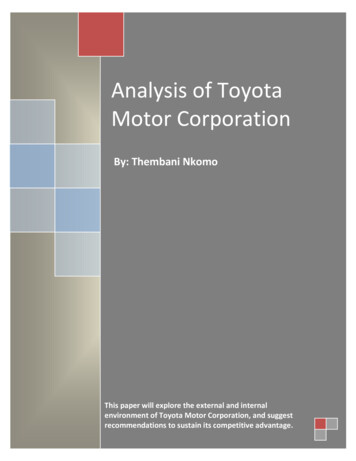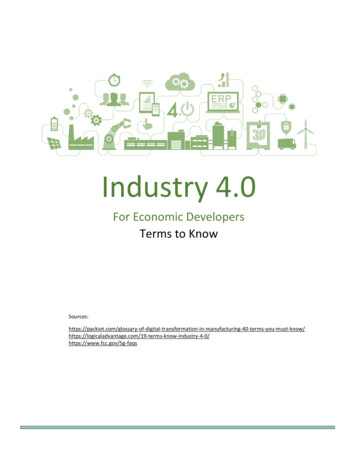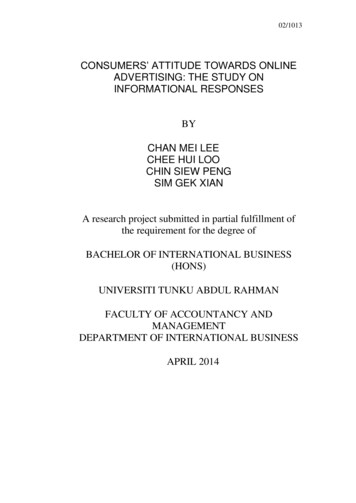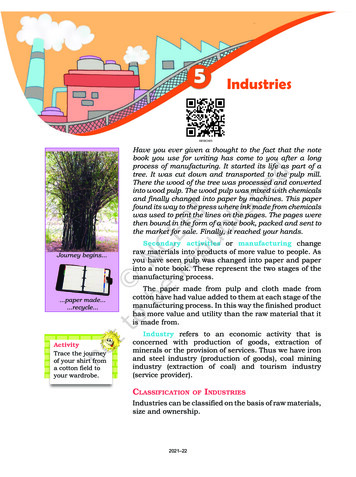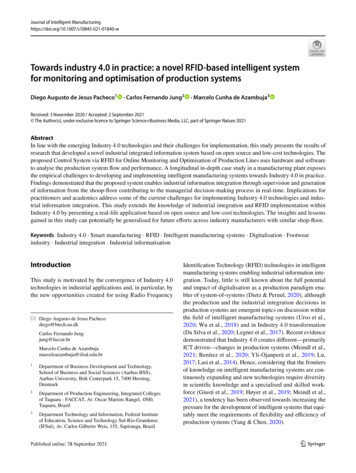
Transcription
Journal of Intelligent 840-wTowards industry 4.0 in practice: a novel RFID‑based intelligent systemfor monitoring and optimisation of production systemsDiego Augusto de Jesus Pacheco1· Carlos Fernando Jung2· Marcelo Cunha de Azambuja3Received: 3 November 2020 / Accepted: 2 September 2021 The Author(s), under exclusive licence to Springer Science Business Media, LLC, part of Springer Nature 2021AbstractIn line with the emerging Industry 4.0 technologies and their challenges for implementation, this study presents the results ofresearch that developed a novel industrial integrated information system based on open source and low-cost technologies. Theproposed Control System via RFID for Online Monitoring and Optimisation of Production Lines uses hardware and softwareto analyse the production system flow and performance. A longitudinal in-depth case study in a manufacturing plant exposesthe empirical challenges to developing and implementing intelligent manufacturing systems towards Industry 4.0 in practice.Findings demonstrated that the proposed system enables industrial information integration through supervision and generationof information from the shoop-floor contributing to the managerial decision-making process in real-time. Implications forpractitioners and academics address some of the current challenges for implementing Industry 4.0 technologies and industrial information integration. This study extends the knowledge of industrial integration and RFID implementation withinIndustry 4.0 by presenting a real-life application based on open source and low-cost technologies. The insights and lessonsgained in this study can potentially be generalised for future efforts across industry manufacturers with similar shop-floor.Keywords Industry 4.0 · Smart manufacturing · RFID · Intelligent manufacturing systems · Digitalisation · Footwearindustry · Industrial integration · Industrial informatisationIntroductionThis study is motivated by the convergence of Industry 4.0technologies in industrial applications and, in particular, bythe new opportunities created for using Radio Frequency* Diego Augusto de Jesus Pachecodiego@btech.au.dkCarlos Fernando Jungjung@faccat.brMarcelo Cunha de Azambujamarceloazambuja@ifsul.edu.br1Department of Business Development and Technology,School of Business and Social Sciences (Aarhus BSS),Aarhus University, Birk Centerpark 15, 7400 Herning,Denmark2Department of Production Engineering, Integrated Collegesof Taquara - FACCAT , Av. Oscar Martins Rangel, 4500,Taquara, Brazil3Department Technology and Information, Federal Instituteof Education, Science and Technology Sul-Rio-Grandense(IFSul), Av. Carlos Gilberto Weis, 155, Sapiranga, BrazilIdentification Technology (RFID) technologies in intelligentmanufacturing systems enabling industrial information integration. Today, little is still known about the full potentialand impact of digitalisation as a production paradigm enabler of system-of-systems (Dietz & Pernul, 2020), althoughthe production and the industrial integration decisions inproduction systems are emergent topics on discussion withinthe field of intelligent manufacturing systems (Urso et al.,2020; Wu et al., 2018) and in Industry 4.0 transformation(Da Silva et al., 2020; Legner et al., 2017). Recent evidencedemonstrated that Industry 4.0 creates different—primarilyICT driven—changes in production systems (Meindl et al.,2021; Benitez et al., 2020; Yli-Ojanperä et al., 2019; Lu,2017; Lasi et al., 2014). Hence, considering that the frontiersof knowledge on intelligent manufacturing systems are continuously expanding and new technologies require diversityin scientific knowledge and a specialised and skilled workforce (Giusti et al., 2019; Høyer et al., 2019; Meindl et al.,2021), a tendency has been observed towards increasing thepressure for the development of intelligent systems that equitably meet the requirements of flexibility and efficiency ofproduction systems (Yang & Chen, 2020).13Vol.:(0123456789)
Journal of Intelligent ManufacturingNowadays, the industrial trend is to work primarily withadvanced technologies to rationalise operational processesand inform industrial managers in real-time. Studies directedto understand the alterations in technologies that permit synchronisation, conservation and maintenance of manufacturing systems can provide facilities with the ability to point outevents accurately to organise that relevant industrial information. In line with the challenges of industrial informationintegration are the studies developing new systems basedon RFID to promote industrial information integration andproductivity improvements in production systems and supplychains (Abugabah et al., 2020; Alyahya et al., 2016; Dosset al., 2020; Ngai et al., 2012; Ullah & Sarkar, 2020; Zhenget al., 2020).Industrial integrated information systems applying RFIDtechnologies provide the real-time tracking ability of theproduction process that suffers unpredictable and recessivedisturbances (Høyer et al., 2019; Leng & Jiang, 2019; Luet al., 2018; Tsao et al., 2017). Moreover, RFID enables thecollection of shop-floor data by the use of labels (TAGs),consisting of a microchip that might be fixed in a pallet,in individual packaging or single products (Alyahya et al.,2016; Zhai et al., 2016). The TAG transmits information toother electronic devices via electromagnetic waves regarding the location, contents and other information (Atkinson,2004). As a result, RFID technologies provide an automaticand accurate data capturing capability and enable real-timeobject visibility and traceability.Although several potential benefits of RFID for industrial integration have been reported for improving shop-floormanagement (Qu et al., 2012; Yang & Chen, 2020; Zhenget al., 2020; Zhu et al., 2012), unfortunately, still today,many industrial managers find it difficult to implement it inpractice due to the complexity and the high costs associated(Abugabah et al., 2020; Giustia et al., 2019; Høyer et al.,2019). In particular, salient difficulties appear in small andmedium enterprises acting in non-mature industrial segments such as footwear manufacturing in developing economies that generally lack resources (Mogos et al., 2019;Orzes et al., 2018) and employ staff members with weakbackgrounds in industrial informatics (Luthra et al., 2018;Vaidya et al., 2018). Furthermore, despite the emergence ofIndustry 4.0 disruptions, the knowledge accumulated basedon empirical evidence about how information systems usingRFID potentials come true in real-life shop-floor operationsare still insufficient (Qu et al., 2012; Yang & Chen, 2020)for several business contexts.Most importantly, although the Industry 4.0 implementation highlights the role of industrial information integration and intelligent manufacturing systems (Meindl et al.,2021), this debate and practical dissemination are prevalentin developed and well-industrialised countries but less salient in the context of developing countries (Da Silva et al.,132020; Dalenogare et al., 2018). This landscape is a concernbecause coherent technologies for performance tracking anddecision-making at the manufacturing and network levelscan be of great significance for firms rapidly responding tomarket demands in volatile mass customisation environments (Leng & Jiang, 2019), a typical challenge faced byfootwear manufacturers. Recently, Industry 4.0 literaturehas been investigated within the boundaries of several studyareas, resulting in knowledge silos and neglected interfacesbetween research topics (Meindl et al., 2021). This impliesthat it is necessary to clearly understand the potentials andadvance in areas underexplored.Additionally, this study is motivated by relevant businessand economic contexts considering the effects of the intensive globalisation of markets and the substantial customisation of products. In this scenario, from the entry of low-costAsian competitors, the footwear industries worldwide havesuffered due to a significant increase in the variety of shoemodels and a reduction in the size of production lots (Pereiraet al., 2010; World Footwear, 2014).Hence, to address the relevant questions outlined above,this study examines the following central question:RQ. How can intelligent manufacturing systems applying RFID promote industrial information integrationin footwear manufacturing to improve manufacturingcompetitiveness?This research presents results designed to develop anintelligent software-supported system by combining production engineering methods with industrial informatics.We combined the expertise of different approaches throughempirical analysis (van der Aalst et al., 2018). The proposedControl System via RFID for Online Monitoring and Optimisation of Production Lines (CSR-OMO-PL) identifies,controls and monitors bottlenecks in production lines in footwear manufacturing, allowing analysis on the shop-floor andvia the web regarding the performance of the production.An original aspect of the industrial integrated informationsystem tested is that all the technologies and programminglanguages used utilise open-source platforms.This study offers important insights and contributes tothe theory and practice extending the body of knowledge oninformation systems engineering by synergically applyingRFID, cloud computing and other Industry 4.0 technologies. This study aims to contribute to this growing area ofresearch focused on the reduction of problems related tothe control and monitoring of production lines. The paperis organised as follows: Initially, we introduce the researchcontext and clarify evidence of RFID use in intelligent manufacturing systems. Next, we present the research methodand the characteristics of the system. The following sectiondetails the architecture and elements of the proposed intelligent manufacturing system. The fifth section presents the
Journal of Intelligent Manufacturingempirical results and discusses the findings and implications.Finally, the conclusion gives a summary and research directions to advance in this research domain.The role of RFID in intelligent manufacturingsystemsProduction environments have become increasingly connected with information and communication technologyin the course of the digitalisation of production systems(Meindl et al., 2021; Miehle et al., 2019). In parallel to thesetransformations, RFID technology has globally impactedseveral manufacturing industries and improved the aspectsof service delivery (Abugabah et al., 2020; Alyahya et al.,2016; Zhai et al., 2016). Notoriously, firms need to optimise the production processes continually to reach the market more quickly and at the proper location specified by theclients. The variety of products on the market has increasedthe complexity of management, the flow and integration ofinformation along the supply chain pushing industrial firmsto adopt new technologies to facilitate the operations (Ngaiet al., 2007). In this concern, RFID can simplify automaticproduct identification and make process control more efficient (Prado et al., 2006).RFID technology plays an essential role in supportingindustrial processes because of its ability to identify, traceand track information throughout the supply chain, providingsuppliers, manufacturers, distributors and retailers with precise real-time information about the products. The accurateknowledge of the inventory levels, for example, will resultin lower costs, simplified business processes and improvedsupply chain efficiency (Zhu et al., 2012). Moreover, whencompared to the barcode systems, RFID technology hasthe following advantages: (1) the labels need not be in thereader’s visual field to be read online; (2) the TAGs can beread in large quantities, almost simultaneously; (3) labelsgenerally can hold more data than a barcode; (4) reading canbe fully automated without an operator; (5) a TAG identifiesindividual items while the barcodes only identify classesof objects; (6) data can be much more detailed due to thepotential for a more systematic collection; (7) the objects—packaged products—labelled with TAGs can be countedautomatically; (8) the read/write labels can receive newinformation throughout the life cycle of the item.Several possibilities for the application of the RFID technology and the increasing global interest resulting from theIndustry 4.0 trends have been observed. For example, theIDTechEx (2012) predicts an increase of the labels market(TAGs), equipment and services of US 1.85 billion in 2005to US 24.63 billion in 2015. The interest of the businesssector in the use of TAGs indicates that the RFID systemsmay rapidly substitute the current alternative technologies.As a result, the labelling (TAGs) of products may increasesharply in the coming years, and the conditions for makingRFID profitable are business trends (Yang & Chen, 2020).Recent developments on RFID have led to a renewedinterest in this technology. For example, to obtain moreprecision in the localisation when positioning RFID TAGs,Xue et al. (2020) developed a hyperbolic and hologramcomposite localisation algorithm. Zhou and Shi (2009) alsodiscussed the issues involving object localisation based onRFID potentials. The interaction of antennas, TAGs andenvironmental aspects was analysed in a passive RFID locating and navigating system for automated guided vehicles(Lu et al., 2018). Moreover, recent research confirmed therelevance of RFID in industrial information integration tasksreinforcing its significance in the diffusion of the Industry4.0 technologies (Lu, 2017). However, investigations discussing control systems via RFID and online monitoringfor optimising footwear production lines have rarely beenanalysed and tested in practice.Regarding empirical works some previous evidenced arepresented. For instance, recently an RFID artefact was developed to aid with Business Process Mapping (Urso et al.,2020). Choy et al. (2017) proposed an RFID-based storage assignment system to enhance order picking efficiency.Leng and Jiang (2019) developed a dynamic schedulingapproach based on the RFID-driven discrete manufacturing system’s multi-layer network metrics. Ullah and Sarkar(2020) applied RFID in a recovery channel to increase therecycling rate of products, while Zheng et al. (2020) testedan RFID-based material delivery model for automobileassembly considering material classification, distributionand optimised delivery. And Giustia et al. (2019) exploredthe RFID contributions to mitigate human error in air-cargohandler warehouses.Already Qu et al. (2012) contribute to the revitalisationof RFID in the industry by presenting a real-life case studyof applying RFID for managing material distribution in acomplex assembly shop-floor at a large air conditioner manufacturer. They also addressed technical, social and organisational issues throughout the production system. Menget al. (2019) created an RFID-based object-centric datamanagement system which was tested in a food manufacturing line. Zhang et al. (2012) developed an RFID-enabledreal-time manufacturing information tracking infrastructureto address the real-time manufacturing data capturing andmanufacturing information processing methods for extendedenterprises. Following the proposed infrastructure, the traditional manufacturing resources such as employees, machinesand materials were equipped with RFID devices (readersand TAGs) to build real-time data capturing. Already Høyeret al. (2019) found that strategic aspects, technical aspectsand convenience are the main challenges regarding RFIDtechnology adoption in dairy firms. The primary external13
Journal of Intelligent Manufacturingbarriers are related to poor responsiveness, delivery reliability and flexibility, and internal to the firm are higher costsand reduced assets management efficiency. In two distinctscenarios, an RFID-based production process for a cloudManufacturing Execution System was created and evaluated(Wang et al., 2018).In sum, several recent studies on RFID applications reinforce this topic’s relevance for the development of industrialinformatisation. However, the landscape of contemporaryliterature demonstrates that studies approaching the RFIDin footwear firms have rarely been studied directly in thelight of industrial information integration challenges. Hence,what follows is a description of the research methodology,data collection, analysis and systems network architecturedeveloped.Materials and methodsResearch context and designThis research aimed to develop and test an integratedindustrial information system, the CSR-OMO-PL, throughhardware, software and RFID technology for real-time integration and optimisation in footwear production lines, resulting in visibility and interoperability during manufacturingexecution. One of the main aspects of the relevance of thisstudy is regarding the industrial and economic context of theresearch. In recent years, the footwear industries in southern Brazil, as in other regions of Europe, Japan and the US(World Footwear, 2014), have suffered from the significantincrease in the variety of shoe models and reduction in thesize of production lots after the entry of low-cost competitors from Southeast Asia and China (Pereira et al., 2010).As a consequence of this intensive globalisation of markets and customisation, orders for large batches and few shoemodels began to be transferred to Asian countries, whileorders for smaller lots and several models remained with theBrazilian enterprises. Smaller lots and high model variabilityare a problem for the footwear industry (Jimeno-Morenillaet al., 2016) for both large and small companies. However,these repercussions are especially critical for small companies service providers (outsourced) in the supply chainacting in markets that have been successively impacted byorder and revenue losses to other competitors.To address these challenges, this research project wassupported and organised with the Union of Footwear Industries in Brazil’s southern region. The union is considered areference organisation in providing training and development of organisational competence for footwear productionin the country. The production system studied, called ‘pilotplant’, considered the characteristics of the production systems in the Paranhana Valley in southern Brazil. The pilot13plant where the system was deployed and tested consists ofa factory equipped especially for training new professionals in footwear manufacturing (“Appendix”). The union isresponsible for the administration of the plant in partnershipwith the firms of the region.Economically, the region has approximately 3690 small,medium and large industries producing footwear, food products, furniture and wood, with the highest concentration ofindustries in the region’s footwear industry. However, thesuccessive national and international economic crises, theforeign exchange rates on exports and the entry of low-costcompetitors from Asia have affected the regional shoe industry in the last decades, imposing complex challenges to thefirms working within the leather and shoe supply chains. Inresponse to this scenario, the academic community, localauthorities and organisations in the region have proposed aseries of actions to increase the added value of the firms toturn the value chain more efficient (Mengden, 2010). Thisresearch, therefore, reports the outcomes of one of theseinitiatives carried out involving academia and industrialstakeholders. The development, tests and validation of thesystem were performed in a three-year longitudinal study.Data collection, analysis and systems networkarchitectureThe manufacturing plant considered for implementing thenew CSR-OMO-PL was based on a type of sequential, segmented production line commonly used in small footwearfirms in the region. Nevertheless, because of the possibilitythat this system could subsequently spread to other firmswith different types of production layouts, provision for flexibility and customisation was made at the stage of analysisof the development of the network infrastructure of the system (Fig. 1). These facilities included the ability to modifythe icons that represent the production layout and types ofequipment, alter the encoding of the TAGs and the mannerof naming the type of product, the standards of the logisticsand others.We utilised open-source programming language andtechnologies available for free on the Internet such as theIDE NetBeans, MySQL database, Hibernate for persistence,the Glassfish web server, the servlet framework VRaptor,JavaScript libraries such as jQuery for the user interfaceand jqGrid for visualising listings. Using open technologiesalso offers the possibility that the system can be continuallyenhanced by other researchers and IT professionals in situations where the new system will be used. All codes andframeworks developed in this research can be available forthose interested upon inquiry to the authors.Ruby 2.2 programming language and the Rails 4.1.9development framework were used to develop the system.Ruby is a multiparadigm and dynamic typing programming
Journal of Intelligent ManufacturingFig. 1 Network architecture of the CSR-OMO-PLlanguage. Rails is a framework that facilitates web applications in the Ruby language, providing security features,integrity and standards for the application. In addition, weused the Bootstrap framework to build the application layoutusing the free Dashgumfree theme. The application databaseused is Postgres and is made available through the Passengermodule for Apache servers.The implementation of the network application followsthe standards of Ruby on Rails projects. With a copy of theproject, just change the settings in the/config/directory aboutthe e-mail and database access data. Then, with the help ofRake Tasks ‘db: create’, ‘db: migrate’ and ‘db: seed’, theapplication is ready to be run via Webrick or Mod. Passenger(Apache).Regarding the network structure (Fig. 1) and the software modules developed, the system has a primary protocol responsible for the continuous reading of the IDs of theRFID TAGs detected by the reader equipment. In this case,the RFID reader remains continuously activated, and whenany TAG in the production system (installed in a container,pallet or single product) approaches the reading range of anyof the antennas of any of the readers installed on the factoryshop-floor, the ID of that TAG is immediately recorded inthe application's database with the following primary information: TAG ID, antenna ID, date and time.The software can then trace the route of each TAG (i.e.,each component) analysing the data history described above.The time spent by a given production lot in each productionarea can be calculated by subtracting two or more recordsof the same TAG ID. Next section details the elements ofthe novel intelligent system and the results from the implementation stages.ResultsWeb interface and configuration for real‑timeinformation integrationThe CSR-OMO-PL has a web interface that users can accessin two ways: (1) local, without a computer located on theshop-floor, or (2) online, from any browser with an Internetconnection. Registered users must enter their access data(e-mail and password), and they will then be redirected tothe home screen.13
Journal of Intelligent ManufacturingThe home screen (Fig. 2) presents an overview of thesystem and provides access to the main menu items. In themain area, the ‘Panel’ with the layout of the production system and the production workflow is presented to the user. Inthe ‘Search’ option, it is possible to localise the TAGs andto insert a description of TAGs registered in the system toobtain location and permanence information in each sector. When entering the first letter of TAG description in thesearch field, the system either presents a list of TAGs thatmatch with the TAG being entered. The Search button willmake a single query, updating the Dashboard with a physical position and permanence of the production lot in eachsector. The Track button starts a constant update process thatupdates times and states instantly.In the left sidebar (Fig. 2), the main menu is displayed,showing the name and e-mail of the user who made theaccess, followed by the action buttons: (1) Dashboard; (2)Summary; (3) Labels; (4) Settings; and (5) Preferences.In the Summary menu, general system collection data ispresented, that is, all readings collected by the antennasand recorded in the database. All tasks performed by theantennas and registered in the database are displayed in thisfield. It is possible to obtain an overview of all the capturesmade or search for a specific summary (people or products),depending on how the TAGs were generated. Also displayedare the label name, electronic product code (EPC), collection date, time information and the antennas which madethe identification.Fig. 2 CSR-OMO-PL interface13In the Labels action menu, the actions for treatment andoperation of TAGs are processed. The ‘TAG Listing’ submenu displays the complete list of all TAGs currently registered in the system, with the option to perform updates.The TAG Generator submenu is one of the primary operations of the system, as it is through this operation that newrecords can be included in the data collection and analysisprocess. To insert a new record, a reference antenna shouldbe selected that will send the data to the new TAG and thenfill it with the information requested by the system.The TAG Groups submenu, on the other hand, allowsgrouping a set of labels according to categories of products may increase sharply such as product groups. The submenu Zero TAGs allows the reuse of TAGs or the use ofnew TAGs, eliminating (zeroing) all data contained in theTAG so that new data can be recorded. Finally, the submenuIdentify TAGs is used to verify what data is contained in agiven label and checks whether it is registered in the system.In the Settings action menu, the system’s main parameters, registration of readers and antennas, users and factory layout are configured. The system display panel (Fig. 3)was designed to support a process flow with quality displayresolutions of 1024 768 pixels or higher. The system alsopermits registration and management of the element (products, lots, and equipment) and prints the TAG and fixes itto the element. The TAG is then registered and monitoredby the Production Manager as the TAG proceeds along theshop-floor.
Journal of Intelligent ManufacturingFig. 3 Screen of the system flowchart after production process configurationFigure 3 demonstrates the screen of a system where it ispossible to set up the production line layout according to theprocess flow. The system allows setting the production flowaccording to the requirements of control and monitoring. Ifonly a part of the process is of interest to be analysed, theuser can change the configuration by simplifying the layoutaccording to the sectors of interest. The configuration andsetting of the user’s production flow are possible becausethe system has resources for sector selection and direction offlow. The user makes a selection, then drags the icon on thescreen and customises the configuration of the productionlayout according to the sectors to be analysed. Regardingthe web-based user interface, the system allows a versatileand easy way to design a very similar production workflowcompared to the real factory layout. There is also the optionfor the user to add personalised elements to be used in thelayout diagram using real machine photos, enabling a usersystem interface layout close to the firm’s reality. This userinterface flexibility allows the design of factory sectors andproduction flows according to the real desired scenarios, asdepicted in Fig. 3. The configuration is a system requirementto address the different characteristics of the production system that that shoe manufacturers might face, for examplea market demanding extreme customisation of shoes andsmall lot sizes.Several other features were made available in the system,such as (1) inclusion of products by name, type and model;(2) registration of labels depending on the type of product;(3) inclusion of suppliers and representatives; (4) registration of antennas in accordance with the production sector;(5) a summary list of TAGs; (6) selection and inclusion ofthe average production time predicted for the sector; (7) anarea for visualisation of the time as a function of the TAGCode, among others. The insertion of the ‘Average Production Time’ forecast also is possible. In this area, the userenters the parameters of time obtained by a time and motionstudy used previously as a base in the firm.System support tools for real‑time informationintegration, visibility and interoperabilityIn addition to the web interface previously presented, theCSR-OMO-PL system was developed with additional support tools (e.g., collector, synchronisation, power testing,list of antennas) to assist the administrator in configuringand operating the system. All functions are available viathe Linux terminal in the application folder (/var/www/app/rfid). The operation of each support tool is detailed below.The collector tool is configured natively on the production manager’s computer to run automatically whenever thecomputer is started. The collector is responsible for communicating with Readers installed on the factory floor andrecording each sector’s data through data reading cycles.13
Journal of Intelligent ManufacturingAt each normal cycle, the system defines the power of theantenna as previously configured, performs the data reading, records the data obtained, and then proceeds to the nextantenna until it contemplates all antennas of the reader (up tothe limit of 4 readers). The total time for a complete collection cycle is approximately 10 s. After executing a cycle
Keywords Industry 4.0 · Smart manufacturing · RFID · Intelligent manufacturing systems · Digitalisation · Footwear industry · Industrial integration · Industrial informatisation Introduction This study is motivated by the convergence of Industry 4.0 technologies in industrial applications and, in particular, by


